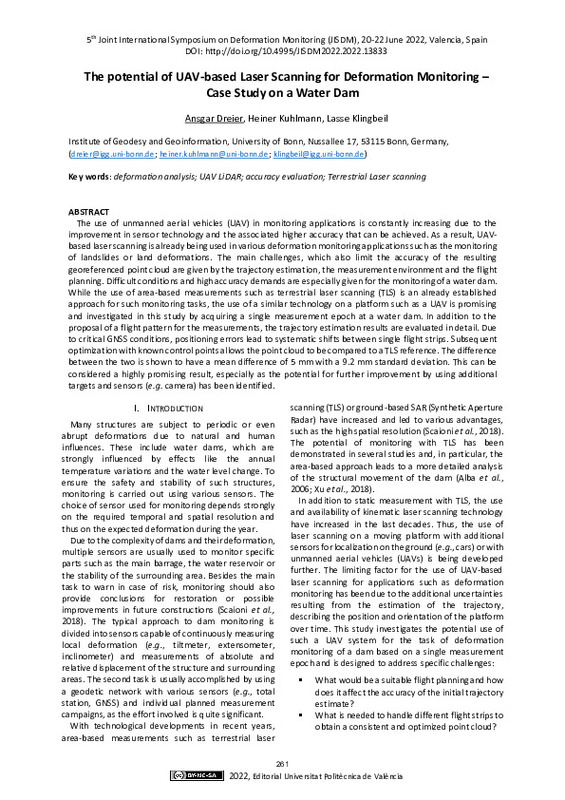JavaScript is disabled for your browser. Some features of this site may not work without it.
Buscar en RiuNet
Listar
Mi cuenta
Estadísticas
Ayuda RiuNet
Admin. UPV
The potential of UAV-based Laser Scanning for Deformation Monitoring. Case Study on a Water Dam
Mostrar el registro sencillo del ítem
Ficheros en el ítem
| dc.contributor.author | Dreier, Ansgar
|
es_ES |
| dc.contributor.author | Kuhlmann, Heiner
|
es_ES |
| dc.contributor.author | Klingbeil, Lasse
|
es_ES |
| dc.date.accessioned | 2023-02-08T13:41:01Z | |
| dc.date.available | 2023-02-08T13:41:01Z | |
| dc.date.issued | 2023-01-27 | |
| dc.identifier.isbn | 9788490489796 | |
| dc.identifier.uri | http://hdl.handle.net/10251/191734 | |
| dc.description.abstract | [EN] The use of unmanned aerial vehicles (UAV) in monitoring applications is constantly increasing due to the improvement in sensor technology and the associated higher accuracy that can be achieved. As a result, UAV-based laser scanning is already being used in various deformation monitoring applications such as the monitoring of landslides or land deformations. The main challenges, which also limit the accuracy of the resulting georeferenced point cloud are given by the trajectory estimation, the measurement environment and the flight planning. Difficult conditions and high accuracy demands are especially given for the monitoring of a water dam. While the use of area-based measurements such as terrestrial laser scanning (TLS) is an already established approach for such monitoring tasks, the use of a similar technology on a platform such as a UAV is promising and investigated in this study by acquiring a single measurement epoch at a water dam. In addition to the proposal of a flight pattern for the measurements, the trajectory estimation results are evaluated in detail. Due to critical GNSS conditions, positioning errors lead to systematic shifts between single flight strips. Subsequent optimization with known control points allows the point cloud to be compared to a TLS reference. The difference between the two is shown to have a mean difference of 5 mm with a 9.2 mm standard deviation. This can be considered a highly promising result, especially as the potential for further improvement by using additional targets and sensors (e.g. camera) has been identified. | es_ES |
| dc.format.extent | 9 | es_ES |
| dc.language | Inglés | es_ES |
| dc.publisher | Editorial Universitat Politècnica de València | es_ES |
| dc.relation.ispartof | 5th Joint International Symposium on Deformation Monitoring (JISDM 2022) | |
| dc.rights | Reconocimiento - No comercial - Compartir igual (by-nc-sa) | es_ES |
| dc.subject | UAV LiDAR system | es_ES |
| dc.subject | Light detection and ranging (LiDAR) | es_ES |
| dc.subject | Unmanned aerial vehicles (UAVs) | es_ES |
| dc.subject | Deformation analysis | es_ES |
| dc.subject | Accuracy evaluation | es_ES |
| dc.subject | Terrestrial laser scanning (TLS) | es_ES |
| dc.title | The potential of UAV-based Laser Scanning for Deformation Monitoring. Case Study on a Water Dam | es_ES |
| dc.type | Capítulo de libro | es_ES |
| dc.type | Comunicación en congreso | es_ES |
| dc.identifier.doi | 10.4995/JISDM2022.2022.13833 | |
| dc.rights.accessRights | Abierto | es_ES |
| dc.description.bibliographicCitation | Dreier, A.; Kuhlmann, H.; Klingbeil, L. (2023). The potential of UAV-based Laser Scanning for Deformation Monitoring. Case Study on a Water Dam. En 5th Joint International Symposium on Deformation Monitoring (JISDM 2022). Editorial Universitat Politècnica de València. 261-269. https://doi.org/10.4995/JISDM2022.2022.13833 | es_ES |
| dc.description.accrualMethod | OCS | es_ES |
| dc.relation.conferencename | 5th Joint International Symposium on Deformation Monitoring | es_ES |
| dc.relation.conferencedate | Junio 20-22, 2022 | es_ES |
| dc.relation.conferenceplace | València, España | es_ES |
| dc.relation.publisherversion | http://ocs.editorial.upv.es/index.php/JISDM/JISDM2022/paper/view/13833 | es_ES |
| dc.description.upvformatpinicio | 261 | es_ES |
| dc.description.upvformatpfin | 269 | es_ES |
| dc.type.version | info:eu-repo/semantics/publishedVersion | es_ES |
| dc.relation.pasarela | OCS\13833 | es_ES |








